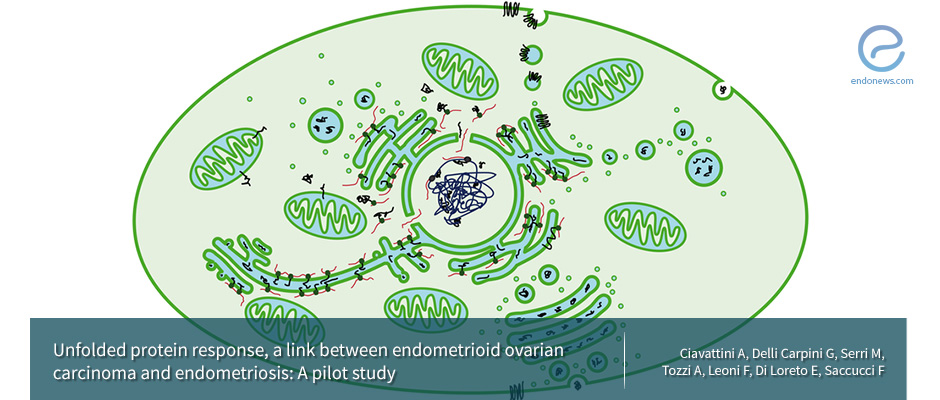A link between endometrioid ovarian carcinoma and endometriosis.
Mar 12, 2019
Unfolded protein response (UPR) neutralizes the apoptotic stimulus in cancer cells.
Key Points
Highlights:
- Unfolded protein response (UPR) is a key cellular defense mechanism to react to environmental or intrinsic stress and is related to the endoplasmic reticulum (ER).
- This ER reaction is changeable due to physiological or pathological conditions depending on the activation of ER transmembrane receptors (ATF6, GRP78, CHOP, and XPB1).
- GRP78 plays role in tumor proliferation, survival, metastasis; while CHOP induction in response to prolonged ER stress causes apoptosis of pre-malignant cells and prevents tumor progression
Importance:
- The alterations in the expression of UPR genes observed in endometrioid carcinoma (increased expression of ATF6 and GRP78, and reduced expression of CHOP and XBP1) appear to promote cell survival pathways and tumor progression.
Key results:
- UPR gene expression was different between endometroid ovarian carcinoma and endometriosis:
- ATF6 and GRP78 gene expression were higher in the endometriotic cyst and endometrioid carcinoma compared to the normal ovaries. While ATF6 expression was similar between the endometriotic cyst and cancer, GRP78 comparatively higher in endometriosis than endometrioid carcinoma.
- CHOP expression tended to decrease in ovarian cancer when compared to both endometriotic cyst and healthy ovarian tissue.
- The expression of XBP1 was also low in endometrioid ovarian carcinoma compared to the normal ovarian tissue, but it was notably higher in endometriotic cysts compared to ovarian carcinoma.
- The endometriotic cysts exhibited a simultaneous increase in ATF6 and GRP78, no difference in the expression of CHOP and XBP1 in comparison to the healthy ovary may mean the neoplastic transformation of endometriotic cyst is likely to occur.
Lay Summary
Ciavattini et al.from Polytechnic University Ancona, Italy create a pilot study which recently published in Oncology Letters to clarify the link between endometriosis and endometrioid ovarian cancer.
The unfolded protein response (UPR) activity as a promoter of neoplastic progression of malignancies is well known. In hypoxic conditions, normally pro-apoptotic signals, cellular metabolic changes, and stimulation of neoangiogenesis occur within the cell, if it could not be restored, terminally ends with apoptosis-mediated cellular death. In a malignant cell, UPR activation via Endoplasmic Reticulum (ER) transmembrane receptors such as ATF6, XBP1, PERK and PKR like ER kinase, the system runs to help the cancerous cell to survive by neutralizing the apoptotic stimulus.
Based on the hypothesis that endometrioid ovarian cancer arises from endometrioma rather than ovarian cells, authors compared the UPR gene expression pattern between endometriotic cysts and endometrioid type ovarian cancer using healthy ovarian tissue as a reference.
To evaluate the possible involvement of endometrioid ovarian cancer UPR pathway, the authors examined the samples from 6 women diagnosed FIGO stage 1A endometrioid ovarian cancer and compared the expression of above UPR molecules to the contralateral healthy ovaries. Affected ovary had higher expression of AFP6, GRP78 and lower expression of CHOP and XPB1 when compared to healthy ovaries.
Secondly, ovarian endometriotic cyst samples of six stage III-IV endometriosis and their endometrial tissue samples were compared. Results showed higher expression of AFP6 and GRP78 in endometriotic cysts compared to healthy ovaries again. CHOP expression was similar to the healthy ovary while XPB1 was overexpressed.
On the other hand, comparing endometrioid cancer to the endometriotic cyst, ATF6 gene expression was similar. GRP78, CHOP, and XPB1 gene expressions were higher in the endometriotic cyst, which means the UPR gene expression pattern of endometriotic cyst is partly different from endometrioid cancer. However, the similarity of AFT6 gene expression indicates increased anti-apoptotic activity in the endometriotic cyst.
Finally, when the authors compared the endometrial tissues of six healthy women to other six women with endometriosis, they found significantly higher XBP1 gene expression in eutopic and healthy endometrial tissue compared to the endometriotic cyst. The lesser XPB1 levels were found in endometriosis, while the least levels were detected in endometrioid cancer.
Authors concluded that URP genes CHOP and XPB1 are involved in the neoplastic progression of endometrioid cancer.
Research Source: https://www.ncbi.nlm.nih.gov/pubmed/30250617
unfolded protein response gene expression endometrioid ovarian cancer endometriotic cyst healthy endometrium eutopic endometrium ATF6 CHOP GRP78 XPB1

